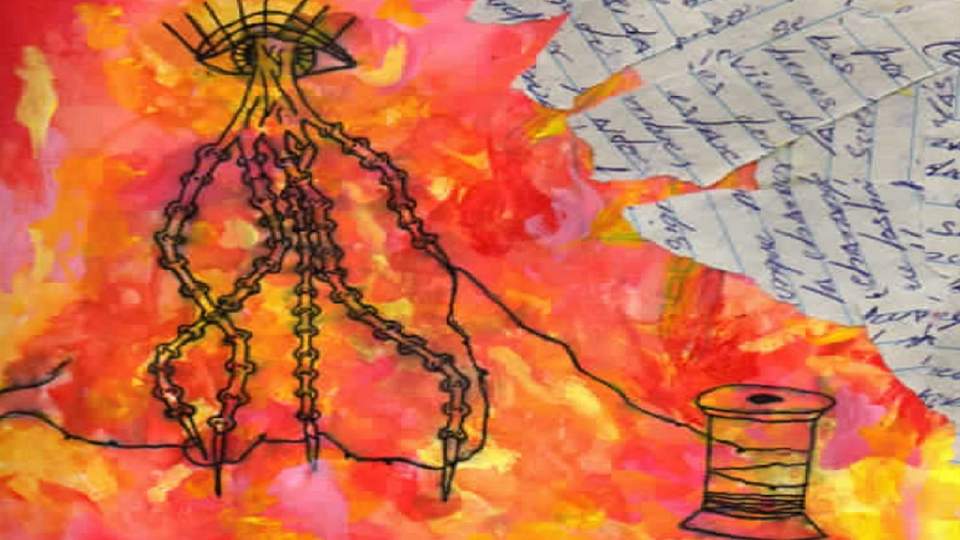By Becca Kurtz

The acting is more compelling than you might expect from student actors, which is why the decision to play younger characters makes so much sense. Sophia Varnai plays the distressed protagonist, Sam, who is trying to fight her literal fates. A gingham dress reminds us that she exists in the present day, and little fidgets punctuate her every anxious monologue. She is frantic but logical. Her sidekick, Dot, played by Jamie Griffith, does not ooze loyalty like other “Best Friend” archetypes do, but rather plays the voice of reason. This teenager is haunted by very different demons than Sam. Griffith is down to earth and provides some relief from the long strands of more abstract poetics. As they run from nowhere, Ohio to Phoenix, Arizona, Sam and Dot realize their differences in a convincing show of solidarity and loss.
Sam’s roadblock enters the stage as Makenna Beam, who intentionally plays both of the characters Sam is uninclined to desert. Beam plays the only decidedly “grown up” roles – a position that isn’t easy as a young adult – with a quaintness about her that satisfies the near senility of her characters. The antagonist is on stage, too, in the form of the three fates. Catherine Horowitz, Anna Brookes, and Sophie Falvey are barely human in their permanent roles as the inescapable inner dialogue, draped in cloth and absentmindedly cutting yarn. The alternating nature of their lines sounds more like poetry than any other piece of Greifer’s script, each of the three voices chiming in at different parts of a sentence. It sounds like music. Terrifying, prophetic music.
The set is simple, not revealing any information about where we are in the world. Rather, three person-sized wooden frames sit side by side on stage, each adorned with strands of yarn and later, painted eyes. Greifer writes in the Director’s note that the play is “covered in loose strings” both literally and figuratively. The wall behind them is decorated with art that is colorful, abstract, and somewhat demonic – as are the masks worn during the play. Lighting by Emma Creekmore contributes to a sense of the surreal, plunging the audience into deep red at certain moments occupied by the protagonist Sam’s thoughts or the three fates’ murmurings. Throughout, sound technician Lily Creekmore makes use of eerie white noise that follows the actors’ voices wherever they go. It’s hard to notice it’s there until it shuts off between scenes, when you realize the room was louder than you thought.
For some, this diversion from a traditional linear, dialogue-based script may be difficult to stomach. But in a 60-minute show, this production makes you feel like you’ve lived another life. The depth of each individual performance, combined with the attention to detail and the immensely personal creative contributions, makes this show a must-see for this year’s Fringe, as Greifer and her team show us all the difference between “leaving” and “moving on.”
Running Time: Approximately 60 minutes.
Mesa, Arizona or Something Like It, presented by Purple Crayon Productions, plays through July 29, 2018, at Westminster Presbyterian Church, 400 I Street SW, Washington, DC. For tickets, go online.
Rating:






we’re we watching the same show? the whole show needed drastic editing and half the lines were completely unintelligible due to the constant yelling of lines. the story was unrelatable and this is coming from a 17 year old (around the same age as the actors and director i assume). i found nothing about this show enjoyable and it definitely didn’t feel like an “all ages” show. the imagery was stomach turning and felt like a mastabatory teenage hannibal fan fiction writer turned play write. the way the writer portrays aging and those who choose to stay in one place was downright disrespectful to our elders to the point where i felt disrespected for them. i left the show feeling that if Dot had just left on his own and Sam had drowned in the flood with her mother, the show would have been worth the money. over all, i feel this production didn’t deserve more than 2 stars, let alone 4. while the acting was good for such a young group, i have to disagree with your review.
On the contrary, I found this show touching and meaningful. I agree that nothing on the stage was cheerful, but I thought that the way Ms. Greifer handled complex themes such as neglect, addiction, and the meaning of home was deft and respectful.
I did not notice any themes in the play of aging, or any elderly characters. The character of the middle-aged mother seemed to me to be a stand in for someone struggling with drug addiction. I thought Ms. Beam portrayed her with grace and depth. The questions raised in the script about when it is right to leave, and whether it was the main character who had abandoned her mother or vice verse, were real ethical dilemmas that left me pondering. The young actors brought energy and emotion to these questions far beyond their years.
I have immense hope for the younger generation after seeing this group channel their fraught adolescent energy into a powerful work of art, rather than ascerbic online criticisms.